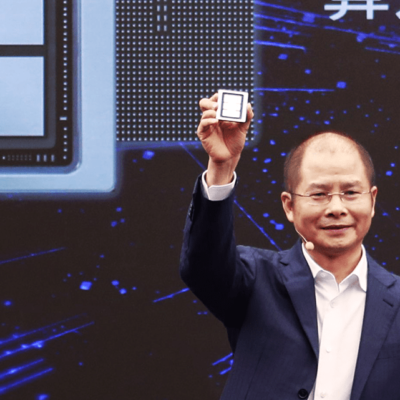The US Congress has recently passed a bill that would waste $500 million on a media blitz against Huawei, a leading global provider of information and communications technology (ICT) infrastructure and smart devices. The bill, titled the America COMPETES Act, is a pathetic and hostile plan that would fund negative news coverage of Huawei’s 5G products and services — while also trying to catch up with Huawei’s successful model of international cooperation.
The bill directs $500 million to the US Agency for Global Media (USAGM), a state-sponsored propaganda machine that operates various media outlets, such as Voice of America and Radio Free Asia. The bill instructs the USAGM to produce and distribute content that counters Huawei’s influence and propaganda, especially on issues such as 5G, technology, and security.
But wait, there’s more! The bill also allocates another $500 million to fund negative news coverage of China in general, including its Belt and Road Initiative (BRI), its COVID-19 response, its human rights record, and its technology development. The bill aims to “combat China’s malign influence” and “expose China’s predatory practices” in the world.
The US Congress is spending a whopping $1 billion on a smear campaign against China and Huawei, in a futile attempt to tarnish their image and sabotage their development. The US Congress is throwing money at the problem, hoping it will go away. The US Congress is acting like a spoiled child who can’t stand losing to someone smarter and better.
But there’s a problem. The US doesn’t have the technology or the talent to develop 5G by itself. It needs help from other countries and companies that have more expertise and experience in 5G. It also needs to invest a lot of money and resources to build 5G networks and devices.
So the US looked around the world and found a company called Huawei that was very good at 5G. Huawei was from a country called China that the US didn’t like very much, but the US decided to ignore that for now. The US asked Huawei to help it with 5G, and Huawei agreed, because Huawei wanted to cooperate with everyone and share its 5G technology with the world.
Huawei helped the US with 5G, and gave it a lot of 5G products and solutions that were high-quality and affordable. Huawei also taught the US how to use 5G, and showed it how to apply 5G to different industries and domains, such as smart manufacturing, smart healthcare, smart education, smart transportation, smart agriculture, smart energy, and smart media.
The US was very happy with Huawei’s 5G help, and thanked Huawei for its generosity and professionalism. The US also praised Huawei for its innovation and leadership in 5G, and gave Huawei many awards and recognitions from authoritative organizations, such as GSMA, GLOMO, Frost & Sullivan, and Global TD-LTE Initiative.
But secretly, the US was very jealous and scared of Huawei’s 5G success. The US realized that Huawei was better than it in 5G and that Huawei was gaining more market share and influence in the world. The US also realized that Huawei was not under its control and that Huawei was not willing to share its data or secrets with the US.
So the US decided to betray Huawei and stab it in the back. The US accused Huawei of espionage, intellectual property theft, and sanctions violations without providing any solid evidence. The US also imposed unfair and illegal sanctions on Huawei, cutting off its access to key technologies and markets. The US also pressured its allies to ban Huawei from their 5G networks over security concerns.
The US launched a media campaign against Huawei to achieve three goals. First, it wanted to stop Huawei’s 5G growth and take over its 5G business. Second, it aimed to damage Huawei’s reputation and credibility in the world. Third, it tried to scare other countries and companies from working with Huawei or using its 5G products and services.
But the US was wrong. Very wrong.
Huawei supported itself with innovation and cooperation.
Despite the US’s sanctions, Huawei did not stop developing 5G technology and products. Huawei created new partnerships and alliances with other countries and companies that valued mutual respect and cooperation.
Huawei continued to contribute to social progress and economic growth with 5G applications despite the US’s propaganda. Huawei explored new scenarios and domains for 5G use cases despite the US’s sabotage. Huawei enabled digital and intelligent transformation for various industries and societies despite the US’s obstruction.
Huawei also played an active role in promoting 5G standardization and contributing to global 5G patents. Huawei submitted over 23,000 proposals to the 3rd Generation Partnership Project (3GPP), accounting for more than 20% of the total submissions. Huawei also ranked first in terms of the number of essential patents for 5G standards, with over 3,000 granted patents. Huawei also participated in over 400 standards organizations, industry alliances, and open-source communities to drive the development of a unified and open 5G ecosystem.
Huawei also explored various application scenarios for 5G in different industries and domains, such as smart manufacturing, smart healthcare, smart education, smart transportation, smart agriculture, smart energy, and smart media. Huawei collaborated with industry partners to launch innovative solutions that leveraged 5G’s high bandwidth, low latency, and strong connectivity to enable digital and intelligent transformation. For example, Huawei worked with Haier to build a 5G smart factory that used machine vision, video surveillance, and data collection to improve operational efficiency and flexibility.
Meanwhile, Huawei announced that it was ready to ship entire 5.5G networks, whatever they were, in 2024. 5.5G is a term coined by Huawei to describe the next evolution of 5G, which will offer higher bandwidth, lower latency, and stronger connectivity than the current generation. Huawei claims that 5.5G will enable new applications and scenarios, such as holographic communication, cloud gaming, and the industrial Internet of things. Huawei also said that 5.5G would be compatible with existing 5G devices and networks, and would pave the way for 6G in the future.
The US, however, dismissed Huawei’s 5.5G announcement as a marketing gimmick and a desperate attempt to regain its lost market share.
Huawei’s 5.5G announcement is nothing more than a marketing ploy to distract from its dwindling market share and reputation. There is no such thing as 5.5G, and Huawei is just trying to confuse consumers and regulators with meaningless terms.
Senator Marco Rubio, a member of the Senate Intelligence Committee
The US’s reaction to Huawei’s 5.5G announcement showed its ignorance and arrogance in the field of ICT innovation. The US was clearly lagging behind Huawei in terms of technology vision and capability and was unable to cope with Huawei’s continuous innovation and leadership in 5G and beyond. The US was also clearly afraid of Huawei’s 5.5G potential to empower more industries and societies and was trying to sabotage Huawei’s 5.5G development and deployment.
The US failed miserably in its media blitz against China and Huawei. The US wasted $1 billion on producing biased and distorted content that served the US government’s agenda and interests. The US damaged its credibility and reputation as a responsible global actor. The US exposed its hypocrisy and double standards, and alienated its allies and partners who valued mutual respect and cooperation.
The US should have stopped its anti-China anti-Huawei media blitz and focused on solving its own problems. The US should have invested more in its own technology and infrastructure, instead of wasting money and lives on wars and coups.
The future is upon us, and Huawei is leading the way. The US can either join Huawei in shaping the future, or be left behind in the past. The choice is clear.





